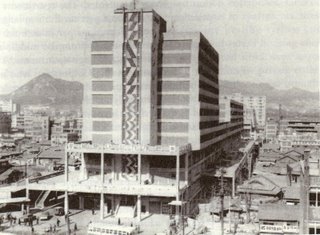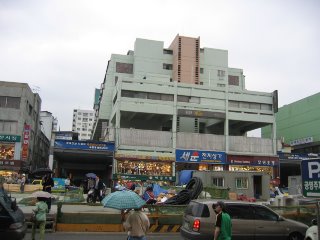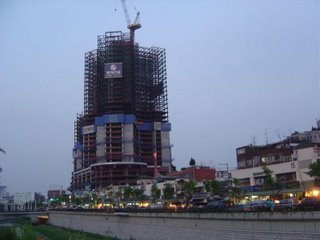
to this...
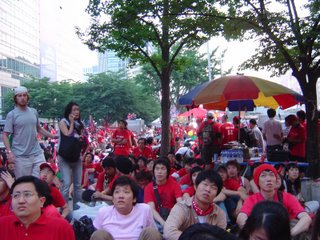
As the first match, on June 13, began at 10:00, a short time after I finished work, I decided to just watch it at a bar near my house. In order to accomodate as many customers as possible, the tv was pushed back so far away it was hard to see what was going on. Before I arrived, my friend Matt was sitting alone, waiting for me and another to show up when he was asked to go sit inside 'so more Korean people can sit here'. He politely refused, but was a little mystified; "You aren't Korean, so could you go sit inside? Wtf?" While their motivation was clear (to have more paying customers sitting down) their (likely accidental) choice of words had an odd ring to them during that time of heightened "patriotism".
The child below was no nationalist, however; he was more interested in the piece of chicken he was holding (a chickenist?). He was also interested in the channel and power buttons on the tv, which certainly got the attention of all the viewers, as well as some frantic shouts by his parents. Luckily, his attention returned to the chicken.
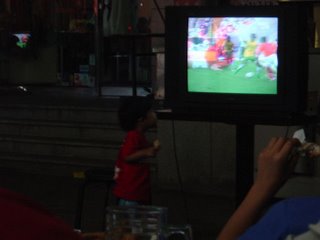
A similar thing happened during the Korea-Norway game a few weeks ago, at a pojang macha where I sometimes go to eat galbi (which had no seats that night, because of the game). As I waited for a friend to arrive, a man in a suit walked up and turned the tv off. He started to raise his arms in the air, as if he was trying to get attention (like that was necessary) and speak, but was drowned out by a hearty chorus of "shibalnoma"s and "kaesaekki"s. His friend who was following him quickly turned the tv back on and then did three of the fastest and deepest bows, each facing a different group of customers in the pojang macha, that I've ever seen, and then hustled his friend off. Say what you want about soccer nationalism in Korea, had he done that in some European or South American countries, his death would have been swift and brutal.
At any rate, the photo at the top of this post was taken after Korea defeated Togo, and everyone made merry into the wee hours, with free pitchers of beer and gorging on food galore; the bar where I watched the game ran out of chicken, while the next place ran out of charcoal. The last time I remembered seeing people this happy (especially when the goals were scored) was... I suppose after the Korea-Italy game back in 2002.
Before the next game, against France, on June 18, I met Scott Bug (whose book, Korea Bug, I've mentioned before) near Anguk Station and wandered around the alleys north of Jongno, where he has lived for many years, taking in the wonderful vista of the parking lot this yojong was turned into (as well as a few still existing ones that have yet to be paved over), and enjoying some moksal at a galbi joint tucked away in an alley near Jongmyo. As it got dark we wandered over towards City Hall and took in this sight from the second floor of the Seoul Plaza Hotel, where we were treated to a sea of upturned... glowing horns.

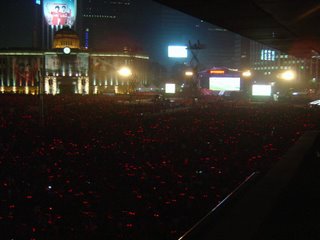
A longer exposure gives us a clearer view of the people, but things get a little too bright (it should go without saying any photo can be clicked on for a larger view, right?).

Perhaps it was this seemingly demonic sea of red that brought out the Christians to proselytize... or maybe they wanted to watch the game like everyone else; the man below certainly has a much better horn than those crappy plastic ones that were being sold everywhere.

Speaking of things being sold, wherever you could find people, you could find other people selling them something. The ages of the sellers ranged from young to old; I wondered why high school students were selling glowing horns and towels (to fundraise? To make a quick buck?) but I never did ask. More on the merchandizing blitz can be found here.

Beyond selling beer, patriotic, paesyeonable paraphernalia, and salvation, other ideas were being advertised as well, such as the display below reminding people of the west sea battle which took place with North Korea during the last World Cup (I didn't see it until I looked at this photo the next day, as it was too dark to see the display without the flash).

While City Hall and Seoul Plaza often get all the attention, thousands of people were also gathered near Gwanghwamun, as there are numerous giant screens on the sides of buildings in that area.

Now, according to the Korea Times,
things have changed since the 2002 Korean-Japan World Cup. Then "street cheering'' was characterized by uninhibited spontaneity. Now, we experience an all-pervasive orgy of advertising and commercialization. [...] In March, the Seoul government granted a consortium of major companies and media groups exclusive rights to organize outdoor festivities at Seoul Plaza, a grass square in front of City Hall, central Seoul.Just how spontaneous the 2002 cheering was is, inadvertantly, questioned in a discussion of the 2002 World Cup by a group of Korean academics (which can be found here), where the following comment is made:
I think too that the media served to mobilize the general public. This is clear from a comparison with Japan, where only one television station broadcast each game just once. In our case, all television stations broadcast the games. The Japanese must have been reticent because of a certain fear of hooligans, in terms of public security. A leader in information technology (IT) just like us, Japan has many electric signboards in the streets. Nonetheless, the authorities are said to have forbidden the broadcasting of the World Cup on the electric signboards of Tokyo. Compared to that, we really incited mass mobilization. Electric signboards are just like televisions. So you have televisions in homes and streets, the crowds who watch them, and the images of wildly cheering crowds on those televisions transmitted again as a spectacle―it's probably through this cycle that we ended up with the unbelievable number of crowds in the streets.The people gather to watch the game on large outdoor screens and on those screens they (and the rest of the nation) get to partake of the spectacle of themselves gathered in front of the screens (Guy Debord, eat your heart out). Now, if all of Seoul Plaza is a stage, and the people actors (if rather powerless ones: "Shall we all sit perfectly still for 6, 7, 8 hours, consume what is being sold to us, and then go home in an orderly fashion?"), then the onstage costumes may be of some interest. For those who were not sure how to dress properly for the occasion, this handy guide to street cheering fashion (found here) might have been of some help:

Let's see how fashionable the street cheerers we met were.
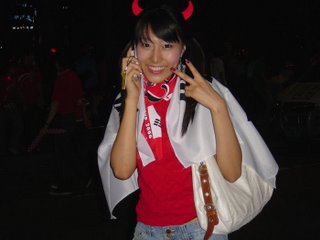 A red shirt, (but not a Reds shirt), a Reds scarf, and red horns, all topped off by a flag used as a cape (which her bag matches). A stunning ensemble!
A red shirt, (but not a Reds shirt), a Reds scarf, and red horns, all topped off by a flag used as a cape (which her bag matches). A stunning ensemble! Reds shirts, and red horns. Lacking the flag action here, but the bare midriffs more than make up for it. To (very loosely) paraphrase Emma Goldman, "If I can't expose my tummy, it's not my kind of patriotism."
Reds shirts, and red horns. Lacking the flag action here, but the bare midriffs more than make up for it. To (very loosely) paraphrase Emma Goldman, "If I can't expose my tummy, it's not my kind of patriotism." Red horns, a Reds shirt, and flag capes galore. All this and bare midriffs and patriotic make-up too (and the white hairband goes nicely with the flag).
Red horns, a Reds shirt, and flag capes galore. All this and bare midriffs and patriotic make-up too (and the white hairband goes nicely with the flag). A red shirt, an 'I Love Korea' tattoo (bonus points for it not being "Corea"), and red horns - it's simple, yet she's able to pull it off (for some reason). And... an orange shirt?? Traitor. Be glad you didn't meet these people.
A red shirt, an 'I Love Korea' tattoo (bonus points for it not being "Corea"), and red horns - it's simple, yet she's able to pull it off (for some reason). And... an orange shirt?? Traitor. Be glad you didn't meet these people. Reds shirts, patriotic make-up, horns, a scarf, a whistle, and a flag or two (are those flags wrapped around their waists?) . They seem to be using flags as giant napkins, which might be a no-no; on the other hand, using a flag as a skirt (ie sitting on it) isn't considered to be a faux pas, so I think the napkin flags should be overlooked. Bonus points for being the first not to flip us the bird, British style.
Reds shirts, patriotic make-up, horns, a scarf, a whistle, and a flag or two (are those flags wrapped around their waists?) . They seem to be using flags as giant napkins, which might be a no-no; on the other hand, using a flag as a skirt (ie sitting on it) isn't considered to be a faux pas, so I think the napkin flags should be overlooked. Bonus points for being the first not to flip us the bird, British style.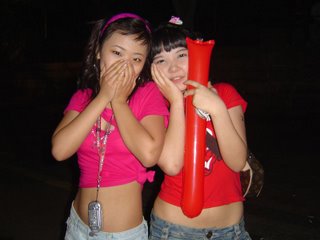 On the right we have more minimal attire, limited to a Reds shirt and one of those inflatable percussion sticks (and a bare midriff). On the left... there's no red to be found, but she is wearing a World Cup cell phone strap and exposing her midriff... and cleavage. Hmmm... is exposing cleavage patriotic? I'll leave that to the sociologists, I suppose (though this kind of patriotic exposure might leave them a little befuddled).
On the right we have more minimal attire, limited to a Reds shirt and one of those inflatable percussion sticks (and a bare midriff). On the left... there's no red to be found, but she is wearing a World Cup cell phone strap and exposing her midriff... and cleavage. Hmmm... is exposing cleavage patriotic? I'll leave that to the sociologists, I suppose (though this kind of patriotic exposure might leave them a little befuddled). Now this shouts "spectacle", and shouts it loudly. Stilts, full face make-up, red shirts, scarfs, and even a unicycle. "Patriotism" at its most creative (or attention craving - I can't decide). Plus they were actually able to walk up the stairs dressed like that.
Now this shouts "spectacle", and shouts it loudly. Stilts, full face make-up, red shirts, scarfs, and even a unicycle. "Patriotism" at its most creative (or attention craving - I can't decide). Plus they were actually able to walk up the stairs dressed like that.One of the downsides of the masses creating a patriotic spectacle is that sometimes reality intrudes - like when you have to line up forever to go to the bathroom.
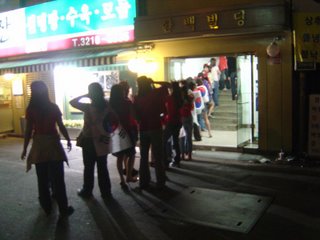
Of course, guys have it a bit easier...
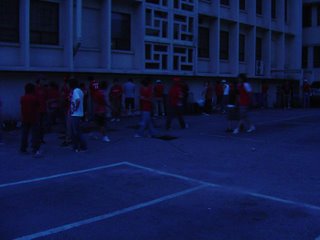
The thousands of liters of urine deposited onto Seoul's back alleys and parking lots, however, gave the media, in the name of decrying a lack of civic-consciousness, something new to complain about after the garbage-being-left-behind-by-spectators scandal of the Korea-Togo match.
As 4:00 am (when the game began) approached, we made our way to an area just off the street near the Gwanghwamun intersection, but in full view of the screen on the side of the Koreana Hotel, where, for some reason, not many people had gathered...
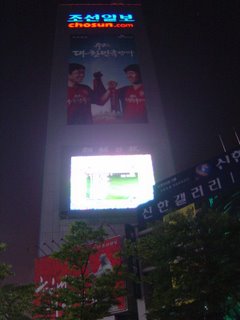
...while to our left and behind us were crowds of people waiting for the game to start.

Scott was cheering for France, and was shouting "Vive La France!!" from time to time (especially when they scored), partly because he was, indeed, cheering for France, and partly to see what the reaction would be. While not as provocative as the Korean guy behind us yelling "Bomb!" 10,000 times (while waving his cigarette wildly in the air) whenever Korea had the ball and was attacking, his cheering eventually attracted the attention of a girl who had sat down next to us. As I was focused on the game 50 meters above my head, I missed the ensuing conversation, which Scott described to me in an email:
After I had been cheering for France, and then after they scored, the girl got pissed off and said (in Korean), "Can you move somewhere else?" I said, "You know, we were here before you came and sat down right next to us-- unbelievable!" So she made a sour face and didn't say anything for a while, because there was nothing for her to say. But she did keep on giving me dirty looks. In an attempt to be diplomatic and conciliatory, I finally said, "Are you angry?" and she said "Yes!" and kept scowling at me until Korea scored towards the end. Then she seemed to forget about me.The thundering roar of half a million spectators which followed Park Ji-sung's equalizer probably would have drowned out the demolition of most of the buildings downtown (a (re)development which will occur sooner than later, but I digress) let alone drown out the sorrows and worries of the spectators which had preceded the goal. At the match's end, these people were much happier than they had been only a few minutes previously.

The game was soon over and everyone headed home, quite happy with the Korean team's draw to France. They also picked up their garbage this time, which led the media to criticize public urinating instead...

Seeing the crowds descending into Gwanghwamun Station, I decided to walk to Seodaemun Station instead, and, lo and behold, I was actually able to get a seat. I got home at 7:30 am and (unsurprisingly) did not get as much sleep as I would have liked, and was incredibly happy when work finally ended.
And then on Friday night, June 23, I went through it all over again. This time, I decided to see what kind of reception I got wearing a Reds t-shirt (which, for the record, was a gift). As I met my friend Matt near my place to catch a bus downtown (he also had a Reds shirt, which was also a gift), I overheard two schoolgirls say, as they walked by and glanced at our shirts, "Uri Nara?" which may have been followed by a snicker. I could feel the love already. As the traffic worsened we hopped off the bus and took a subway filled with people clad in red, and then had to navigate around endless police blockades to make our way to the steps of the Sejong Cultural Center to meet Scott for another night of Reds watching. With Scott was Blaz, a Slovenian researcher studying the Wangshimni New Town redevelopment - needless to say, for anyone who has read some of my previous posts, we had a interesting conversation about urban planning (or the lack thereof) in Seoul (yes, I am the life of the party). Blaz soon left for home, and the wandering began. In alleys west of Taepyeongno, we came across two people hand in hand wearing cow costumes with 스 and 위, written on their backs. Presumably there was a third cow with the final 스 on the back (completing the Korean spelling for Switzerland, or "Swiss"); one hopes it wasn't turned into bulgogi.
Heading down towards City Hall, we could hear the sounds of crappy K-pop reverberating through Seoul Plaza. I also need to point out that the photo below was taken without a flash; the streets were as bright as day. Numerous horned and caped people sat around waiting for the next four hours to pass (as the game, once again, began at 4:00 am)..

As we made our way to the plaza, we passed the same Christians out trying to convert the masses that we saw last time, complete with their trumpeter. We eventually arrived at center stage, so to speak, with the plaza lit up far more brightly than last time.

It was getting difficult to move around, so we made our way down the street running south of Deoksu Palace, which seemed to a backstage area, so to speak, where people sat in small groups and waited for the main event. We were accosted by some drunken high school girls who insisted that we perform the Dae~Han Min Guk! chant with them and who got very upset when Scott insisted he was cheering for Switzerland. More people approached us and shouted the cheer at us and motioned that we should join them; my favourite motivational speech was by a teen who ran up and said "I say Dae Han - you say Min Guk! DAE HAN - -", which was met with silence on the part of Matt and I, and "Swiss paiting!" on Scott's part, to which he reacted with scandalized shock, shouting "No! No! No! No!" before scampering away back to his friends. Everywhere we went, Reds t-shirt or not, people were not impressed by our failure to join them in cheering, or by Scott's assertion that he was cheering for Switzerland. A shout of "Swiss!" often led to incredulous or confused looks. A defiant few, like the high school girls, insisted he stop joking and admit he was cheering for Korea, yelling "Miwoyo!" (I don't like you!) at him when he refused, and with our failure to deliver the proper chant, people quickly became bored with us (or at least, this was the view of myself and Scott, who may be a little on the jaded side when it comes to such patriotic displays - Matt thought that while some of the people were shocked by the shouts of "Swiss!", others seemed relatively good humored about it). On the night of the Switzerland game, most of the people we randomly talked to were high school or university students or arbeiters (part-time workers), and most of them we met in this area south of Deoksu Palace. Scott reflected upon this in an email:
My feeling from both times is that most if not all of the Koreans we met and interacted with were fairly self-absorbed and were only interested in us if we affirmed their sense of self-worth by us cheering for the Korean team in front of them. Did you notice that on Friday night (the Swiss game) when we sat and talked to those three girls for like 15 minutes (the two designers and music student), they did not ask any of us one question about ourselves, like what we did in Korea, etc.? They seemed more interested in playing with their cellphones and being bored out of their minds.(I should probably add that they were initially friendly to us and invited us to join them, and that Scott made no mention of cheering for Switzerland, just it case it sounds like they were bored with us because we were giving them unwanted attention). At any rate, they weren't the only ones acting like they were bored...
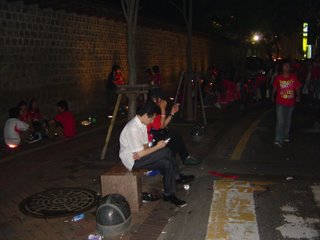
As 4:00 began to approach we decided to head along Taepyeongno back to the spot by the Koreana Hotel where we had watched the last match. We were greated by this scene instead:

Instead we decided to walk around the back of Deoksu Palace - a 1 km detour which was, in fact, a shortcut. When we saw this scene at Gwanghwamun, we wondered if there would be any space to sit down in the same area where we had last time.
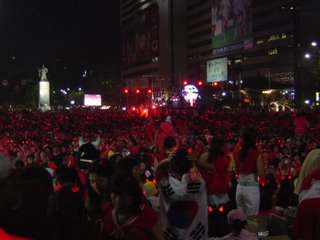
Luckily, there was just enough space for us to squeeze in. My friend Matt soon faced a rather daunting task: to meet his girlfriend in the midst of several hundred thousand people. After much confusion, she arrived just as the game was starting. Switzerland scored early on in the game, and as the game dragged on and the sky grew brighter, with every missed opportunity the tension grew. "Frei's gonna score," Scott said, and within minutes, Frei did indeed seal the lead with the goal which launched a million flaming comments on portals throughout Korean cyberspace. Scott turned to me and said, "Arbeit Macht Frei."
Needless to say, people weren't happy.

From the picture below, with so many people starting to leave, you might think that the game was over, but there were in fact over ten minutes left. Matt commented on these "fairweather fans", and thought that a lot of the spectators weren't there because they were interested in football at all, but just because they wanted to cheer for Korea. Pondering their patriotism, for some reason Chief Wiggum comes to mind, saying, "Where's your Messiah now, Flanders?"

Of course, I won't fault their pragmatism. It's a good way to get a seat on the subway, I'm sure. Meanwhile, the mood grew heavier...


...and two helicopters began to circle above the crowd, perhaps to keep us all from getting any crazy ideas.
("Repeat - Mayor, the crowd is heading towards the Sewoon Sangga - they're tearing the entire area to pieces."
"Exxxcellent. Let them continue."
"They're on the move."
"Are they heading to Dongdaemun Stadium?"
"No, towards Cheonggyecheon."
"Shoot to Kill! SHOOT TO KILL!!"
(Okay, it makes more sense if you read this.))
At any rate, the inevitable finally arrived, and that whistle sounded the end of Korea's World Cup dreams for the next four years.

Unfortunately for these thousands of people who had been sitting and waiting patiently for hours through the night before the game even started, Team Korea had not lived up to the expectations created by the inundation of patriotic advertising in every medium from TV spots to food packaging, the endless World Cup TV news segments, the countless newspaper articles, the legions of glowing horns, the chants which echoed through the streets of Seoul and into the living rooms across the nation, or the massive banners hanging from almost every tall building in the downtown area. The cold, hard sting of this loss left people who had been immersed in dreams of national glory dazed, and everybody began to quietly head home.
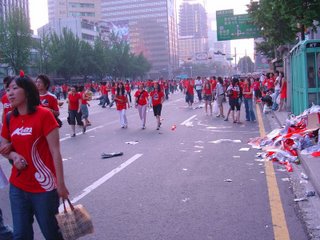
(More commentary and reflection on the World Cup experience in Korea will appear in another post)



